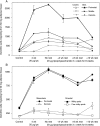Changes in adipocytes and dendritic cells in lymph node containing adipose depots during and after many weeks of mild inflammation
- PMID: 16367804
- PMCID: PMC1571578
- DOI: 10.1111/j.1469-7580.2005.00506.x
Changes in adipocytes and dendritic cells in lymph node containing adipose depots during and after many weeks of mild inflammation
Abstract
The time course and cellular basis for inflammation-induced hypertrophy of adipose tissue were investigated over 20 weeks in mature male rats. Mild inflammation was induced by subcutaneous injection of 20 microg lipopolysaccharide into one hind-leg three times/week for 4 or 8 weeks, followed by up to 12 weeks 'rest' without intervention. Mean volume and frequency of apoptosis (TUNEL assay) were measured in adipocytes isolated from sites defined by their anatomical relations to lymph nodes, plus numbers of CCL21-stimulated lymph node-derived and adipose tissue-derived dendritic cells. Experimental inflammation increased dendritic cells and adipocyte apoptosis in the locally stimulated popliteal depot and the lymphoid tissue-associated regions of the contralateral popliteal and mesentery and omentum. Responses declined slowly after inflammation ended, but all measurements from the locally stimulated popliteal depot, and the omentum, were still significantly different from controls after 12 weeks rest. The locally stimulated popliteal adipose tissue enlarged by 5% within 4 weeks and remained larger than the control. We conclude that prolonged inflammation induces permanent enlargement, greater adipocyte turnover and increased dendritic cell surveillance in the adjacent adipose tissue and the omentum. The experiment suggests a mechanism for selective hypertrophy of lymphoid tissue-associated adipose tissue in chronic stress and inflammatory disorders, including impaired lymph drainage, Crohn's disease and HIV-associated lipodystrophy, and a link between evolutionary fitness, sexual selection and aesthetically pleasing body symmetry. It would be useful for further study of molecular mechanisms in inflammation-induced local hypertrophy of adipose tissue and development of specific therapies that avoid interference with whole-body lipid metabolism.
Figures




Similar articles
-
The cellular structure and lipid/protein composition of adipose tissue surrounding chronically stimulated lymph nodes in rats.J Anat. 2003 Jun;202(6):551-61. doi: 10.1046/j.1469-7580.2003.00188.x. J Anat. 2003. PMID: 12846476 Free PMC article.
-
The effects of dietary lipids on dendritic cells in perinodal adipose tissue during chronic mild inflammation.Br J Nutr. 2004 Jun;91(6):883-92. doi: 10.1079/BJN20041147. Br J Nutr. 2004. PMID: 15182392
-
Site-specific differences in fatty acid composition of dendritic cells and associated adipose tissue in popliteal depot, mesentery, and omentum and their modulation by chronic inflammation and dietary lipids.Lymphat Res Biol. 2004;2(3):107-29. doi: 10.1089/lrb.2004.2.107. Lymphat Res Biol. 2004. PMID: 15609811
-
Adipose tissue and the immune system.Prostaglandins Leukot Essent Fatty Acids. 2005 Jul;73(1):17-30. doi: 10.1016/j.plefa.2005.04.005. Prostaglandins Leukot Essent Fatty Acids. 2005. PMID: 15946832 Review.
-
Long-term changes in adipose tissue in human disease.Proc Nutr Soc. 2001 Aug;60(3):365-74. doi: 10.1079/pns200198. Proc Nutr Soc. 2001. PMID: 11681811 Review.
Cited by
-
QTL for body composition on chromosome 7 detected using a chromosome substitution mouse strain.Obesity (Silver Spring). 2008 Feb;16(2):483-7. doi: 10.1038/oby.2007.26. Obesity (Silver Spring). 2008. PMID: 18239664 Free PMC article.
-
The Effect of TGFβ1 in Adipocyte on Inflammatory and Fibrotic Markers at Different Stages of Adipocyte Differentiation.Pathophysiology. 2022 Nov 23;29(4):640-649. doi: 10.3390/pathophysiology29040050. Pathophysiology. 2022. PMID: 36548206 Free PMC article.
-
Liposuction Treatment of Lymphedema.Semin Plast Surg. 2018 Feb;32(1):42-47. doi: 10.1055/s-0038-1635116. Epub 2018 Apr 9. Semin Plast Surg. 2018. PMID: 29636653 Free PMC article. Review.
-
Adipocyte inflammation is essential for healthy adipose tissue expansion and remodeling.Cell Metab. 2014 Jul 1;20(1):103-18. doi: 10.1016/j.cmet.2014.05.005. Epub 2014 Jun 12. Cell Metab. 2014. PMID: 24930973 Free PMC article.
-
The Immune System in Obesity: Developing Paradigms Amidst Inconvenient Truths.Curr Diab Rep. 2017 Aug 15;17(10):87. doi: 10.1007/s11892-017-0917-9. Curr Diab Rep. 2017. PMID: 28812211 Free PMC article. Review.
References
-
- Bedoui S, Velkoska E, Bozinovski S, Jones JE, Anderson GP, Morris MJ. Unaltered TNF-α production by macrophages and monocytes in diet-induced obesity in the rat. J Inflamm. 2005;2 10.1186/1476-9255-2-2. - DOI - PMC - PubMed
-
- Björntorp P. The regulation of adipose-tissue distribution in humans. Int J Obesity. 1996;20:291–302. - PubMed
-
- Curat CA, Miranville A, Sengenès C, et al. From blood monocytes to adipose tissue-resident macrophages – Induction of diapedesis by human mature adipocytes. Diabetes. 2004;53:1285–1292. - PubMed
-
- Dhurandhar NV, Kulkarni PR, Ajinkya SM, Sherikar AA, Atkinson RL. Association of adenovirus infection with human obesity. Obes Res. 1997;5:464–469. - PubMed
-
- Dhurandhar NV, Israel BA, Kolesar JM, Mayhew GF, Cook ME, Atkinson RL. Increased adiposity in animals due to a human virus. Int J Obesity. 2000;24:989–996. - PubMed
MeSH terms
Substances
LinkOut - more resources
Full Text Sources

